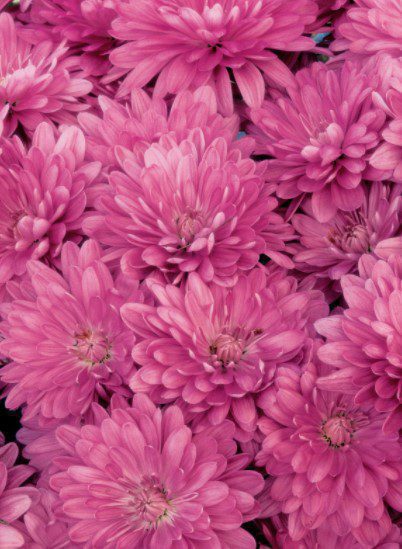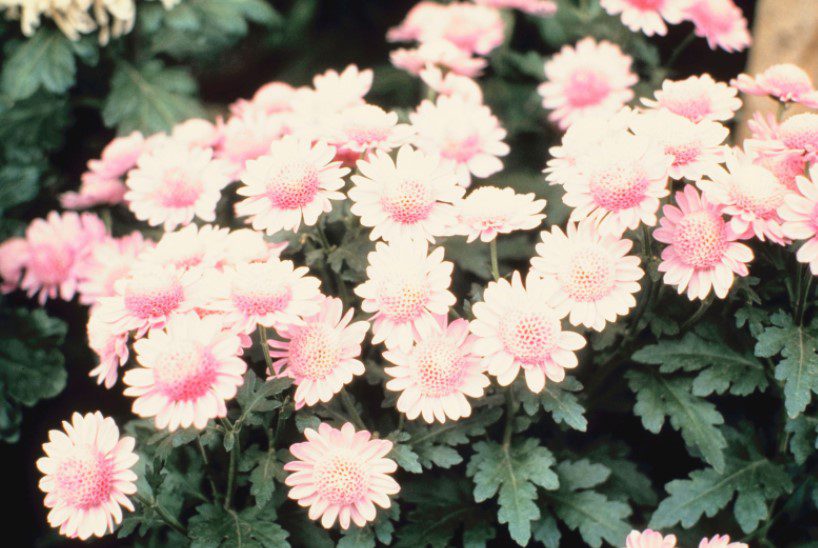Mums
Chrysanthemums this time of year always capture my attention. They naturally bloom in the fall, and you and I have come to associate them with autumn.
The popularity of garden mums has continued to rise significantly over the past decade. Ed Higgins of Yoder Brothers Inc., a leading breeder of chrysanthemums, expects the trend to continue.
He reports that garden mum sales easily have doubled of late.
Using sophisticated and specialized breeding and selection techniques, the overall plant habit and performance of garden Chrysanthemums have improved dramatically, Higgins says.
“No longer are garden Chrysanthemums tall and lanky,” he explains.
Here are the steps on how to grow cascading fall mums:
1. Start cuttings in March.
2. As each cutting grows, tie the main stem to a stake to keep it straight. Pinch the lateral shoots about every 10 days, leaving only two sets of leaves. This forces the main stem to grow fast and makes the plant fuller since the pinched laterals will grow additional branches.
3. Water and feed as needed. Don’t let the plant wilt.
4. When your plant is 2 feet to 3 feet long, repot to a seven-gallon container.
5. Elevate the container so the mums can cascade to the ground.
6. Gently bend the main stem downward. Tie with “twist ’ems” to a wireframe.
7. Continue to tie down the main stem and pinch the lateral and bilateral shoots for the fullness.
8. Make your last pinch about six weeks before blooming begins in September. Such a plant should produce about 1,000 blooms. New ones will keep opening for about two weeks after the first ones appear. Your flowers will last about six weeks or until the frost gets them.
9. When blooms begin to die, trim them off.
How To Care For Mums In Winter
Do you have chrysanthemums in the yard that have finished flowering? If you do, cut off the faded blooms if the foliage has browned, cut the stems back to around 4 inches off the ground.
Is the area where your plants are located one where water does not collect? If melted snow water or spring rains pool over the chrysanthemum plants or, even if drainage is lousy so that the soil in the area remains moist, the Chrysanthemums should be removed and planted in a higher, drier location.

There are two reasons why chrysanthemums do not survive the winter. The first is that so much attention has been paid to broadening the color range and flower form of mums that, in some instances, cold hardiness has been lost.
The plants are just not able to survive the cold of our area. Knowledgeable gardeners choose chrysanthemums with “Minn” as part of their name, for these cultivars were bred in the cool northern states.
The second reason mums do not survive a New England winter is because the plants rot away from too much moisture.
During their dormant stage, plants are susceptible to long-term immersion. Some gardeners actually lift the Chrysanthemums plants out of the ground after flowering and place them in an out-of-the-way location covered with pine branches for the winter. You can replant them in the spring.
Other perennials that have completed their yearly life cycle should also have brown foliage removed, and their stems cut back.
Mums And Pests
A principal reason mums and other perennials have their foliage pruned off is not to make the garden look neater but rather to sanitize the garden by removing the overwintering sites for insects and diseases. Removing dead foliage to the compost heap will reduce pest problems for next year.
Mums Care Tips
Do you have spring bulbs that have not been planted yet? There is still time to install them into the ground. The soil is warm and moist. Plant bulbs as soon as possible.
Remember to use 10-10-10 or similar fertilizer when setting the bulbs because it will accelerate their rooting-in process.
After planting is completed, the soil should be lightly raked, then watered. The water initiates root growth, and the fertilizer supports the extension of roots.
The soil should be mulched with pine or fir bark to maintain warm soil temperatures. Under a mulch, the ground will remain sufficiently warm to stimulate root growth for another month, which is plenty of time for the bulbs to ready themselves for spring flowering.
If rodents feeding on spring bulbs has been a problem in the past, you may elect, after planting, to lay hardware cloth (a type of wire mesh) over the planted area, pin the mesh down and cover everything with the layer of mulch.
The wire stops the digging up of the bulbs. It should be removed in the spring before bulb foliage appears above ground.
As the outdoor areas are being prepared for winter, houseplants are preparing to assume a central role during the dark months. Are any of the holiday cacti numbered among your houseplant collection?
Some bloom around Thanksgiving and may repeat-flowering at Easter, while others flower at Christmas. The holiday cacti are available in a range of flower colors, including red, shades of pink, gold, and white.
All of them share a liking for cool night temperatures. If the plants are exposed regularly to temperatures above 65 degrees at night, they are unlikely to bloom.
If the night temperature is between 65 and 55, the holiday cacti will bloom if, like poinsettias, they are given continual darkness from 5 p.m. until 8 a.m. At temperatures below 55, the plants will bloom regardless of the light to dark period.


























